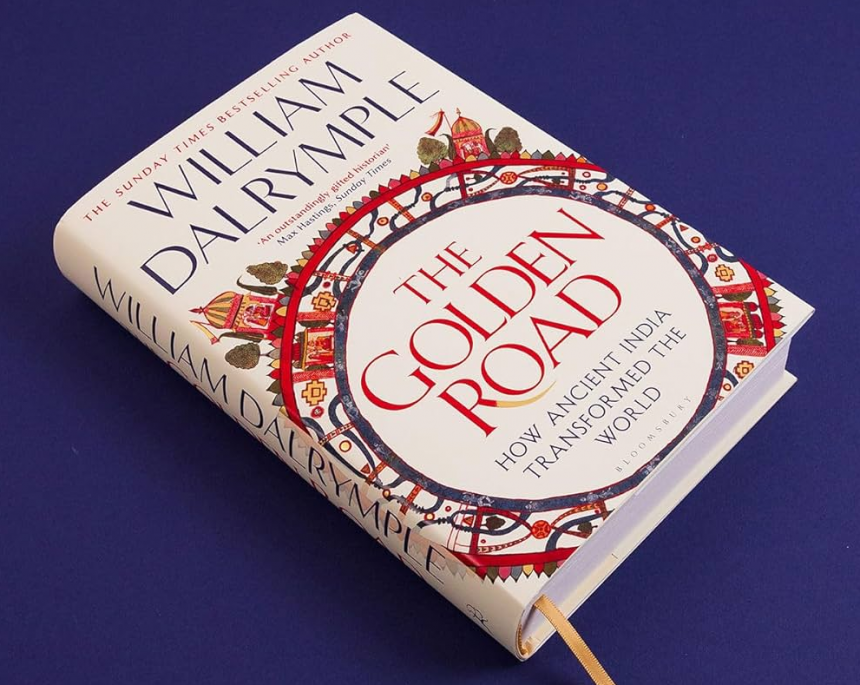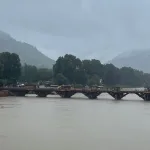BOOK REVIEW
It has been often observed with a mix bag of consternation as well as intrigue that most of the seminal works concerning with dispelling age old myths connected with downsizing India’s contribution to the world at large in matters science & technology, art, culture, trade, economics etc befell on a foreign writer. Much of this intrigue could be a creation of our colonial past which had a hidden agenda to undermine, under report, misrepresent and devalue India’s transformative effect on the religions and civilizations around it. Otherwise how could our colonial masters set out to bring their own civilization to a part of the world ( read India) that was already recognized as supremely civilized for thousands of years and which indeed was spreading its influence all over Asia long before the coming of Christianity?
Partly it could be a homegrown culture spearheaded by our short sighted historians guided by the expediencies of the situations as suited their needs. ‘People of distant places, with diverse customs’ wrote a Chinese Buddhist monk in the early 7th century CE ‘generally designates the land they most admire as India. ‘Xuanzang’ was one of China’s greatest scholars, travellers, and translators. When he wrote these words, he had just returned from an epic 6000 mile overland pilgrimage to the great centers of Indian learning.
Welcome to one of the most seminal works on Indian art, culture, history, trade, economics, people and their habitats going by the title –“The Golden Road- How ancient India transformed the world” by world renowned Indologist William Dalrymple. This book has within its pages such mine of information which has the potential of causing innumerable ripples in the literary world and also turn the theory of ‘Silk route’ to a secondary importance vis-a vis the ‘Golden road’ as enunciated by the celebrated Scottish writer.
Reams of paper and tons of ink have been consumed the world over by renowned writers eulogizing the all too importance of the iconic ‘Silk route’ and its centrality in uniting the traditional power centers of trade, commerce, and such like issues often placing China and the Chinese as the corner stone of such ventures. Though it is true that the Silk route was the brain child of Chinese during the ‘Han dynasty’ by ‘Zhang Quian’, but then the ‘Golden Road’ book by the celebrated Scottish writer aims to highlight India’s often forgotten position as a crucial economic fulcrum, and civilizational engine at the heart of the ancient and early medieval worlds and as one of the main power houses to grant traction to global trade and cultural transmission in early world history, fully at par with and equal to China.
The silk route a brain child of China went all the way from Xian (present day Shaanxi province) in north central China and stretched west along the Great Wall of China, across the Pamirs through Afghanistan and into the Levant and Anatolia. A total distance of about 6500 kms that was active from second century BCE until the mid-15th century. Contrarily the ‘Golden road’ of India as enunciated by the author was much more humongous in its entirety with its ‘western branch’ starting from Indian ports like the ‘Barygaza (Bharuch), Kanheri (present day Mumbai) and Muzeris (present day Kodungallur of Kerala) cutting all the way the Arabian sea and connecting distant places like Basra, Baghdad, Medina, and port Alexandria in Egypt. The eastern branch of this Golden road branched off from ports like Kanchipuram and Tamralipta (present day east MedInipur of WB) cutting across the Bay of Bengal and heading to ports like Borbodur in present day Indonesia. Both the western and eastern branches of this Golden road summed up more than 13,000 kms, twice the distance of the Silk route of China. And still the world sings paeans in favour of the Chinese Silk route.
Over the course of more than 1000 years, Indian religions, philosophies, and sciences spread out in all directions across the ‘Indosphere’; a terminology that has been repeatedly used by the author showcasing entire spectrum of early Indian influence that was always there hiding in plain sight. From Buddhism of Sri Lanka, Tibet, China, Korea, & Japan in the place names of Burma and Thailand, in the murals and sculptures of the Ramayana and the Mahabharata in Laos and Cambodia, in the Hindu Gods, rituals and temples of Bali; the all too pervasiveness of Indian footprint is unmistakable. This seminal superlative research and painstaking scholastic work has been befittingly indexed into contents numbering from one (1) to ten (10) with an equally excellent introduction titled as ‘The Indosphere’. Chapter one deals with title –‘A gale of stillness’ going on to chapter 2, 3, 4 and so on till chapter 10 with titles as diverse and interesting as ‘India: The Sink of the world’s most precious metals’ to ‘The great king, kings of kings, son of God to ‘The fifth concubine’, ‘In the lands of God’, and so on finally ending with ‘Fruits of the science of numbers.’
‘The Golden Road’ book first explores the birth of Buddhism in the 5th century BCE as a usually non –violent and relatively egalitarian movement that rose as part of a great philosophical churning and transformation, partly in reaction, on one hand to early vedic Hinduism with its strict caste hierarchies and its mass sacrifices of animals, and on the other to the harsh austerities of the ascetic Jains. It follows Buddhism’s sudden leap to prominence under emperor Ashoka, who helped consolidate Buddhism as a pan –Indian religion and who sent missionaries around the world to spread the ‘Dharma’ –the path of duty and morality. The same chapter tells the story of the spread of Buddhism into Tibet and china, transforming culture, life and thought eventually becoming the ‘Court religion’ through the influence of the remarkable ‘Wu Zetain’, the first and only female emperor of china.
The next few chapters of this superlative book throw light at roughly the same time, the ruling elite of south –Asia overwhelmingly converted to the worship of Hindu Gods, while Buddhism became increasingly popular, first with the merchant class then with the ordinary people, so much so that ‘Thervada Buddhism’ remains the dominant religion today in much of the region. The influence of the Indic Gods and Indic religions and the whole scholarly, cultural and linguistic apparatus that came with them eventually spread over the greater part of Asia from Afghanistan in the NW to the far east Japan, from Sumatra in the south to Siberia in the north, Indic religions have now dominated Asia’s religious, theological, philosophical, cultural, economic and political discourse for almost 2000 years now.
The final chapters of the book will tell story of how Indian mathematics, such as the number systems we still use, the decimal system, algebra, trigonometry and the algorithm as well as the astronomical discoveries first passed from India to Abbasid Baghdad in the late 8th century. The centrality of the Indian sub-continent as one of the two ancient economic and cultural hubs of Asia and of its ports as the principal places of maritime east-west exchange has also been partially obscured by the ‘Sinocentric’ concept of the ‘Silk road’, an overland trade route said to stretch all the way across Asia from China to Turkey and the eastern shores of the Mediterranean. Despite its modern popularity the idea of Silk Road was completely unknown in ancient or medieval times; not a single ancient Chinese or western record throws light on this iconic route. It is here that this seminal work of William Dalrymple comes to the rescue of the concept of India being at the center of all activities driving human development index to its hilt of all those countries which came into its contact via this Golden road.
It is a travesty of justice as well as ironical that the said road of human development in which India had such a big part to play was pushed to the margins either due to combined machinations of time, foreign invasions (read Mongol) that foreclosed the option of using the western branch of this Golden road or due to a complete lackadaisical effort on the part of historians (read Indian) to record the contributions as warranted by the actions of this road. Rather China has upped the ante against India again by showcasing this long forgotten Silk Road in a complete new avatar—‘Belt road initiative’ known in China as ‘one belt one road’ now often referred to as the new ‘Silk road’. India in the past and even today has been again short shifted from claiming its part of glory under the sun partly due to its own doings and more so by failing to read the machinations of its detractors (read China) which reinvented history to suit its present requirements.
Be that as it may, in the light of the recent Sino-Indian thaw of relations, it is high time that writers like William Dalrymple and his works are included in the national curriculum of higher education to remove the so called distortions of Indian history as enunciated by the present Modi dispensation. The book published by ‘Bloomsbury publishing’ needs no introduction to the literary world as well as to an avid reader which is an epitome in publishing business all across the world. It has an impressive bibliography, acknowledgments and plate sections to depict the painstaking work of Mr Dalrymple.
Priced at Rs 678/ as a hardcover, the work of William Dalrymple has been modestly priced looking at the tremendous hard work the writer has put in. With an attractive cover depicting India’s historical monuments, the look of the book itself encapsulates the contents inside. A must buy book for an avid reader who is interested in knowing what India was in the ancient times and the route ahead.
(The writer is a retired army officer and a regular scribe of Rising Kashmir. He can be approached on his email: [email protected])








